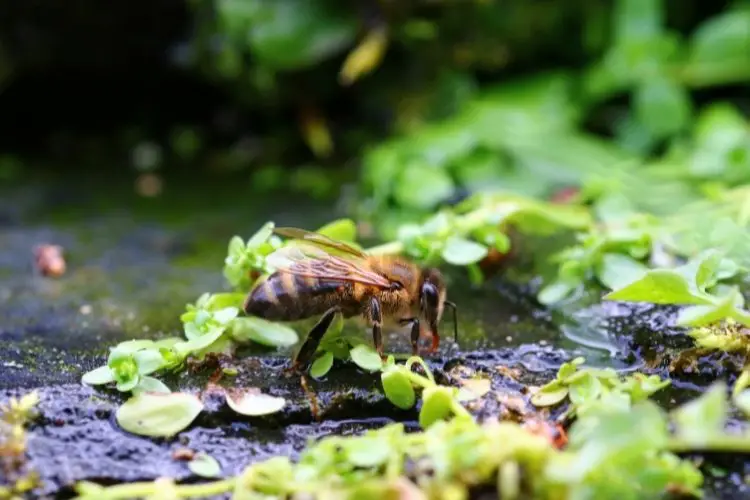Like humans, honey bees need to drink water. Not only will bees drink directly from pools, but they will also collect water and carry it back to their hive. However, it is quite common for bees to get stuck in water and drown while doing so.
If you have a swimming pool in your backyard, or even a small pond or birdbath, you may have seen dead bees floating in the water. This prompts the question – can bees swim? And if so, why do they drown so often?
Bees can swim – just not very well. In fact, a more accurate statement would be to say that bees can glide or ‘surface swim’, because that’s essentially what they do. They stay afloat and use their wings to glide along the surface of the water.

Bees Swim (Or Glide) Along The Water’s Surface
Bees don’t submerge themselves in water and swim below the surface like humans. Instead, their wings help them float and propel them slowly towards the water’s edge, where they can crawl out to safety.
A study published in the Proceedings of the National Academy of Sciences examined the way in which bees swim along the surface of the water. The researchers dropped bees into shallow water (between 2.5 – 5cm, or 1 – 2 inches deep), and observed their reaction.
The study found that bees use their wings as hydrofoils, which means their wings generate hydrodynamic thrust (thrust exerted by the water).
In other words, bees flap their wings to create a series of small ripples with a wavelength of about 5mm (0.2 inches). They then ride these tiny waves to generate forward motion.
In the study, some bees landed upside down when dropped into the water. They were not able to upright themselves after hitting the water – but they were still able to use their wings to propel themselves forward.
Bees were recorded swimming along the water’s surface at speeds of between 1-3 body lengths per second (that’s 1.4 – 4.3cm per second, or 0.5 – 1.7 inches).
It requires a lot of energy for bees to move their wings in order to propel themselves forward, meaning they become tired quite quickly.
The study didn’t measure how far bees could swim before stopping. However, it’s fair to assume that, if a bee lands in a large pool of water, it may drown before successfully gliding towards the edge.
It’s also important to point out that a bee cannot crawl out of the water if it is surrounded by vertical walls. It’s why bees often drown in large, enclosed bodies of water such as swimming pools, whereas they are more likely to escape from water sources that have sloped edges.
Why Can’t Bees Just Fly Out Of Water?
When a bee lands on water, its buoyant body and wings help it to float. However, it can’t just flap its wings and fly out of the water.
That’s because there isn’t enough space beneath a bee’s wings and the water to create the significant amount of thrust needed for take-off.
Plus, the bee’s wings become wet, making them heavier than usual, which also adds to the difficulty. It’s also possible that the lower body temperature makes it harder to vibrate their wings at a high frequency.
Why Do Bees Often Drown In Water?
Bees need to drink water to stay alive. Water also plays an essential role in cooling the internal temperature when the weather is hot. Bees collect water, carry it back to the hive and place small droplets throughout. They then fan their wings to create cool currents that lower the hive’s temperature.
When the weather is hot, bees will visit sources of water more frequently. The more they go near water, the more bees will drown. It’s simply a hazard when being around water so often – sometimes bees will fall in.
Unfortunately, bees can’t breathe underwater. Instead, they hold their breath in a similar way to what humans do (though their respiratory systems are different to very ours). However, they can’t survive very long if they find themselves stuck in water.
The safest way for a bee to drink is to land at the water’s edge. If a bee becomes stuck in a pool of water, the only way to safety is to glide to the edge.
How To Stop Bees From Drowning In Water
If you have bees in your backyard and want to provide them with a safe way to drink, you can fill shallow containers (or a birdbath) with water and place rocks inside. The rocks give bees somewhere to land on while they drink.
Containers with sloped edges as opposed to vertical walls are also a good idea, as they make it possible for bees to surface swim to the water’s edge and crawl out. A large bowl, for instance, can work well as a source of water.
Interestingly, when given a choice, bees tend to choose dirty water over clean water. They’ll drink from puddles, ponds, birdbaths, pet dishes, swimming pools – anything they can find that is fragrant and rich in nutrients.
Though it’s difficult to tell exactly why this is the case, it’s believed that the scent of the water source makes it easier for bees to find – whether it’s the smell of mud, algae, bacteria or even chlorine.
Final Thoughts
Honey bees are not strong swimmers like many mammals (or even some insects). However, they are able to use their wings to ‘surface swim’ along the water at speeds of up to 3 body lengths per second. This is their only hope of survival if they fall into water – otherwise, they will drown.
